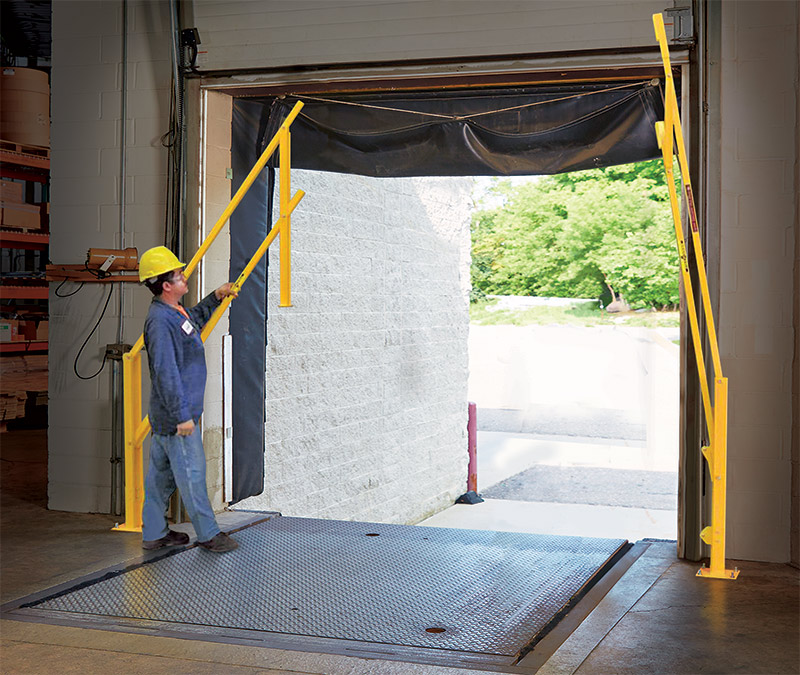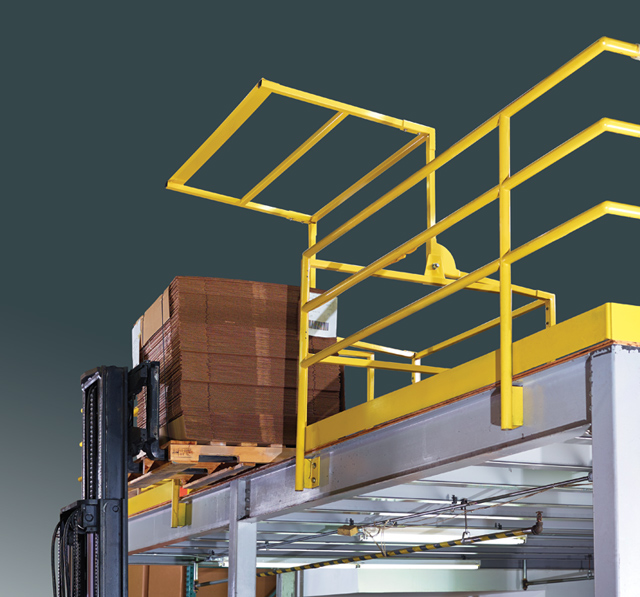
As the holidays draw near, the top concern for many fulfillment and distribution centers is finding enough workers to handle the surge in holiday orders that accompanies the holiday season. While anxiously preparing for the increase in holiday activity, it can be easy to overlook key safety measures that offer OSHA fall protection. Below is a look at the top challenges for fulfillment and distribution centers along with the top ways to keep employees and visitors safe during the holiday rush.
What are the top challenges for fulfillment and distribution centers during the holidays?
Holiday sales accounted for 20% of total sales made in 2017. In an effort to prepare and dispatch orders in a timely fashion, order fulfillment and distribution centers often increase their staff, their inventory, and their daily number of deliveries and pickups. This increase in bodies, products, and vehicular traffic can put employees and visitors at a heightened risk for injury. Here are some of the main challenges facing fulfillment and distribution centers during the holidays:
1) Crowded aisles
During peak season, aisles are more likely to become overcrowded as fulfillment centers begin to run short on space. OSHA does not sympathize with stores or fulfillment centers that fail to adhere to safety standards due to overcrowding. In fact, one New York business received over $160,000 in fines for safety issues that included overcrowded aisles and failure to safely stack merchandise.
2) Increased loading dock congestion
“Loading docks can be dangerous. About 25 percent of all reported warehouse injuries occur on loading docks, and for each incident hundreds of near misses occur. Causes of dock injury include truck separation from the dock and falls from the dock – particularly when a forklift backs off the platform and falls on the operator.”
– Safety + Health Magazine
An increase in holiday deliveries and pickups can lead to a congested loading dock area. Failure to properly mitigate this congestion can leave your employees at increased risk for falls and bodily injury. West Bend Mutual Insurance Company outlines some of the most common loading dock hazards, including the following:
- Heightened fall risks due to employees stepping or jumping from a high elevation to a lower one
- Forklifts and pallet jacks rolling off docks onto employees below
- Products falling onto employees during a rushed loading process
3) Overloaded mezzanines
“Fall-related accidents also are an ever-present danger in elevated work areas such as mezzanines. Additionally, an increasing number of plants and warehouses have pit areas that workers can fall into if they are not guarded properly.”
– Andy Olson, EHS Today
Mezzanines enable fulfillment centers to increase their storage space without leasing additional space or relocating. Unfortunately, mezzanines can become overloaded with inventory and warehouse staff during the holiday season, putting employees at a higher risk of injury.
4) Snow and water on the floors
Adherence to OSHA fall protection standards is especially important during the holiday season when wet and snowy weather can plague fulfillment centers located in colder, wetter regions of the United States. Jennifer Taylor of the Solus Group describes how winter weather during peak season creates a need for additional safety measures:
“When warehouses and distribution centers operate at peak capacity — or, even worse, beyond — the risk of workplace injuries increases exponentially. There are more workers on the ground, and they’re all moving faster than normal…Even winter weather conspires to increase the risk of slips and falls by depositing a healthy coating of snow onto everyone’s boots. It may be snow on the dock, but it will soon be water on the warehouse floor, which is a recipe for disaster.”
– Jennifer Taylor, The Solus Group
What is the best way to address these challenges?
Overcoming the challenges outlined above requires diligence and planning on the part of fulfillment center owners. Failure to take measures to address hazardous conditions in the workplace can lead to an increase in employee slips and falls. Below are five ways for fulfillment and distribution centers to help safeguard against workplace injuries during the holiday rush.
1) Ensure temporary staff receive proper safety and compliance training
Large fulfillment centers such as Amazon often double their workforce during the holiday season, outlining the need to make sure that temporary staff are sufficiently trained on safety and compliance measures. In addition to being trained on safety policies and procedures, temporary staff should receive special training on fall safety protection from the moment they pass through your industrial gate.
2) Install loading dock safety gates
Loading dock safety gates help safeguard against falls in two key ways. First, they provide a visual barrier for truck drivers and warehouse personnel. Second, they serve as an effective OSHA fall protection mechanism by guarding open doors and loading docks during the holidays. A loading dock safety gate is particularly effective when used in conjunction with an industrial gate to provide an extra layer of protection.
3) Introduce mezzanine safety gates
Mezzanine safety gates can help prevent employees from falling into pits or onto lower levels of a distribution center. Installing a safety gate in your mezzanine area can also help deter unauthorized visitors or employees from accessing mezzanine areas.
4) Consider leasing additional space
Leasing additional space is a wise option for fulfillment centers that have exceeded their maximum capacity. In addition to easing loading dock congestion, additional space provides relief for warehouse employees who are struggling to maneuver through crowded warehouse aisles and overloaded mezzanines. Ideally, the space you lease should feature loading dock safety gates, mezzanine safety gates, and at least one industrial gate to help protect employees and logistics workers.
5) Designate at least two staff members to clean and dry warehouse floors
“The floor of every workroom shall be maintained in a clean and, so far as possible, a dry condition. Where wet processes are used, drainage shall be maintained, and false floors, platforms, mats, or other dry standing places should be provided where practicable.”
– OSHA 1910.22 (a)(2)
Keeping the floors of your distribution or fulfillment center clean and dry is essential to protecting against slips and falls during the holiday season. If snow, rain, or ice is in the forecast, you may wish to use a system of dock sealing products to help prevent water from overtaking your loading dock area. At a bare minimum, make sure you have staff on hand to make sure that your floors are kept clean and dry.
The Bottom Line
The holiday season is the busiest time of the year for fulfillment and distribution centers. It can also be one of the most dangerous times of the year for full-time staff and temporary employees. By following the five steps above, you can help ensure that falls and other workplace accidents are minimized during the holidays.









